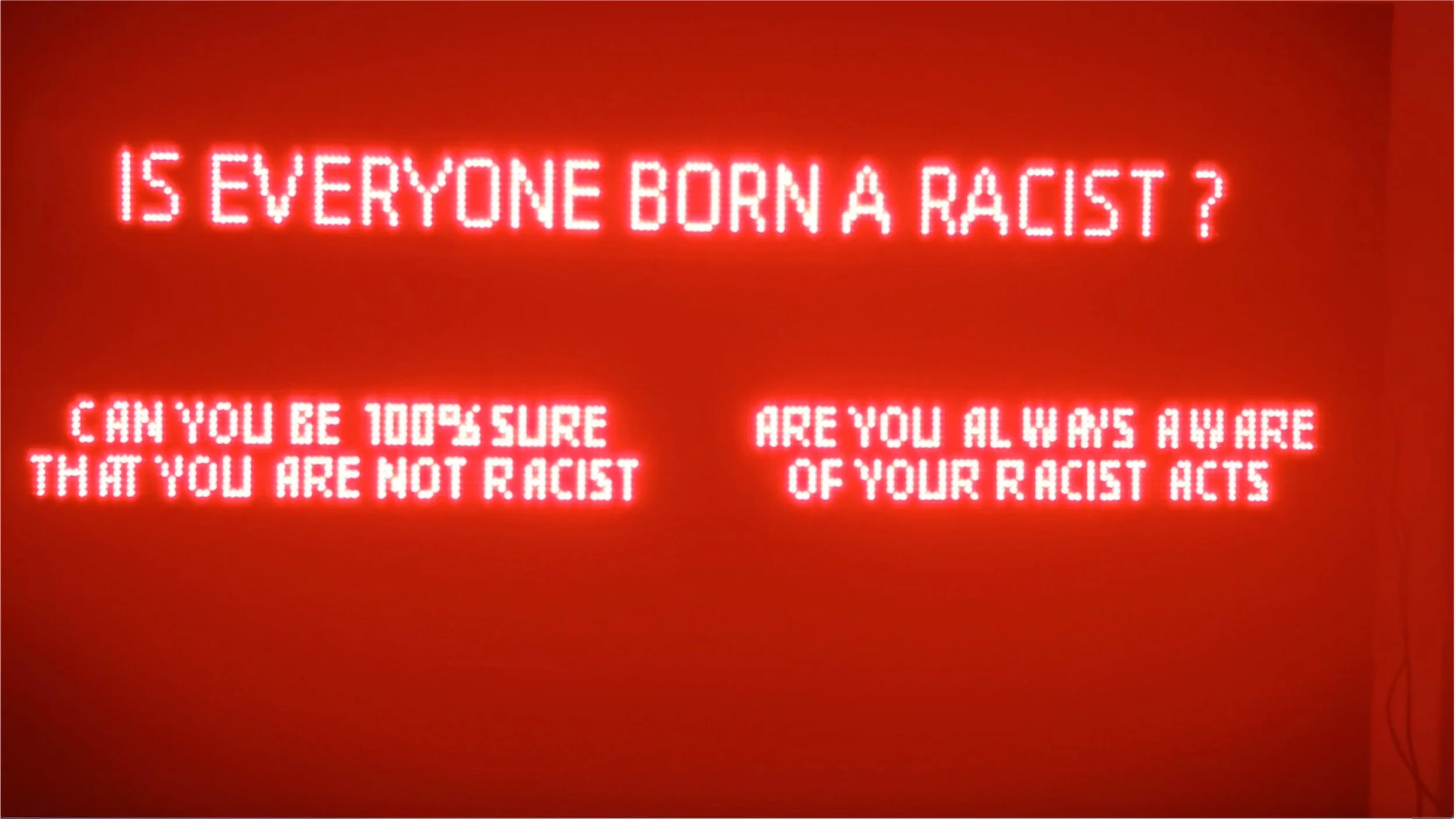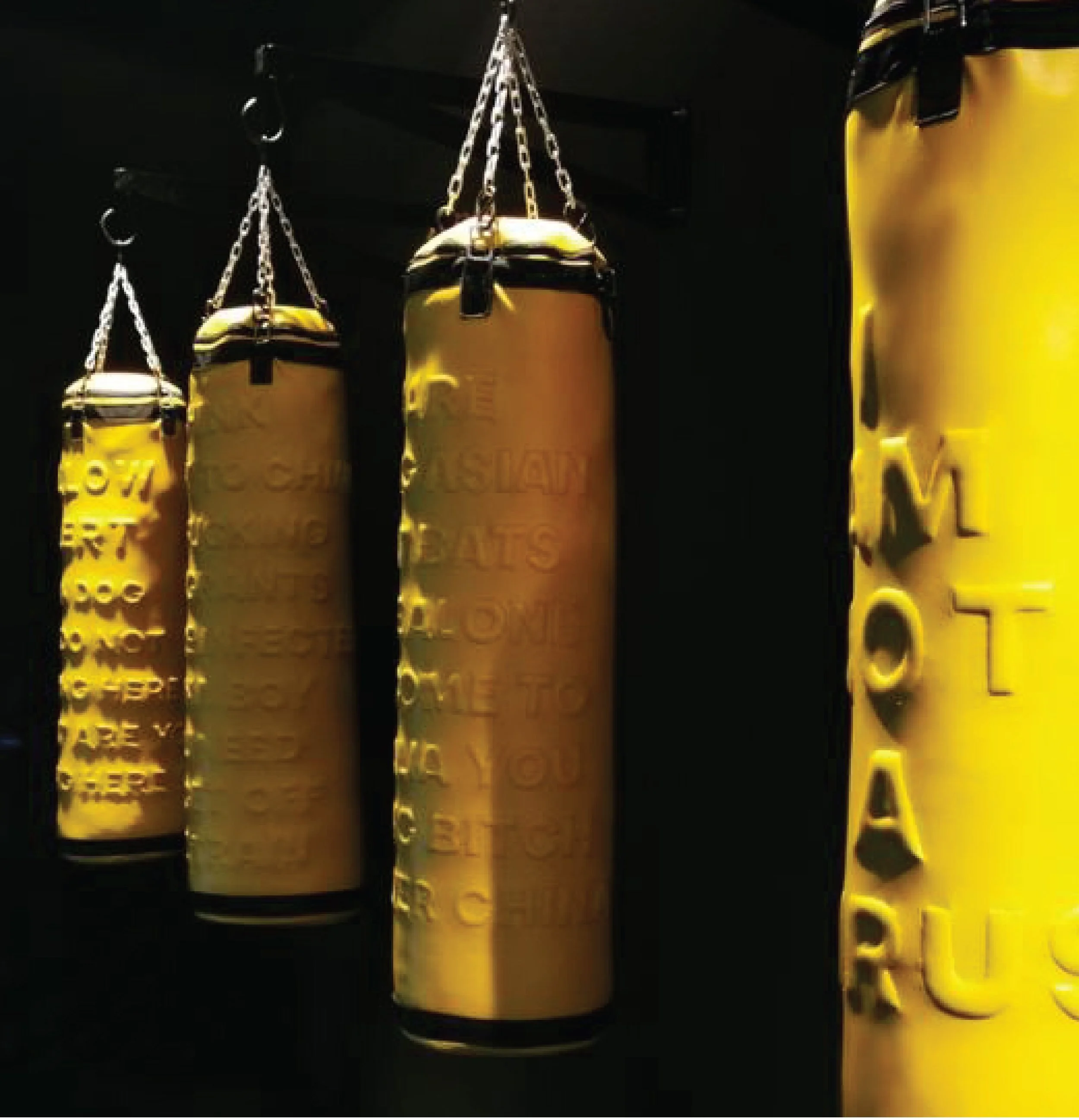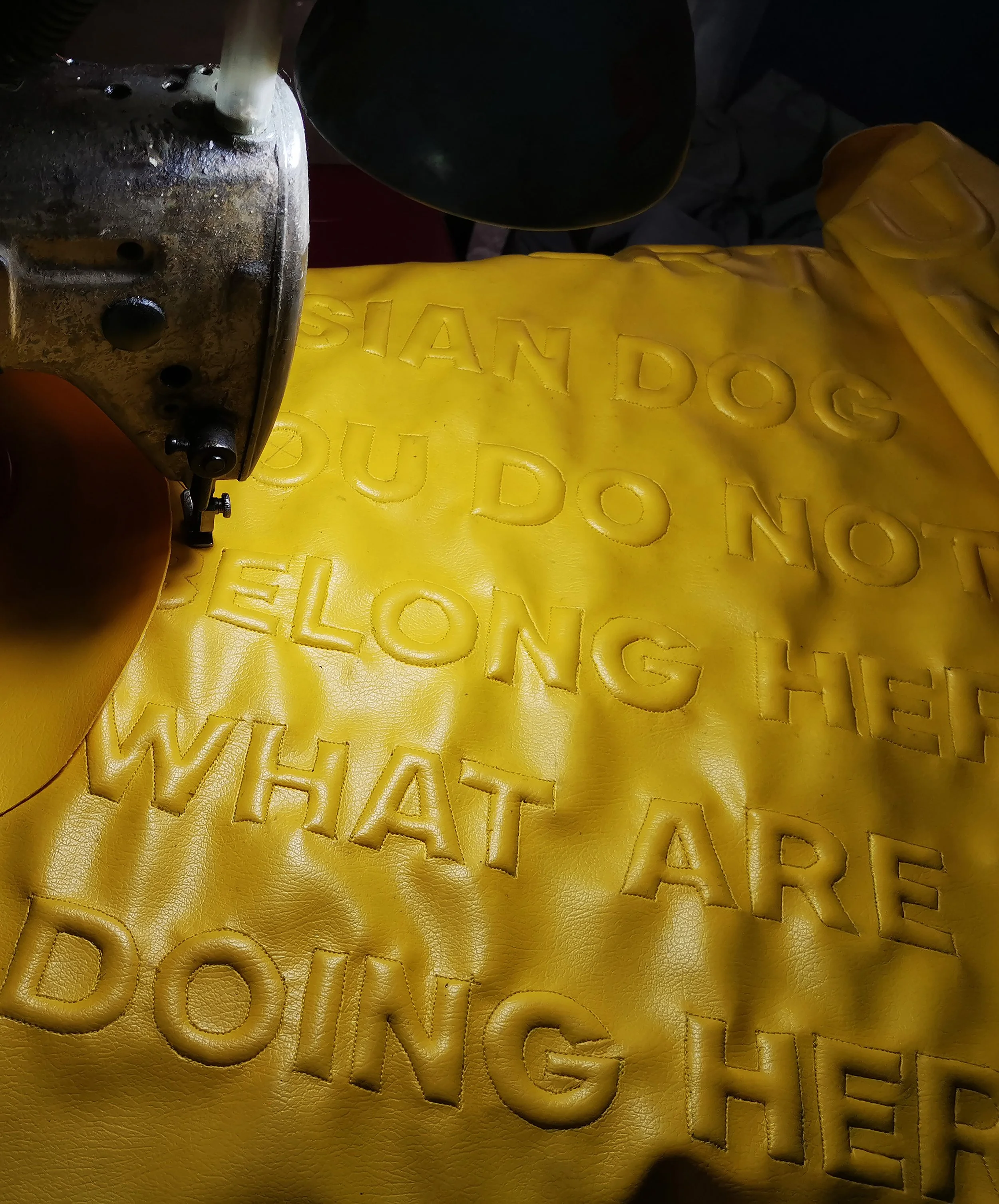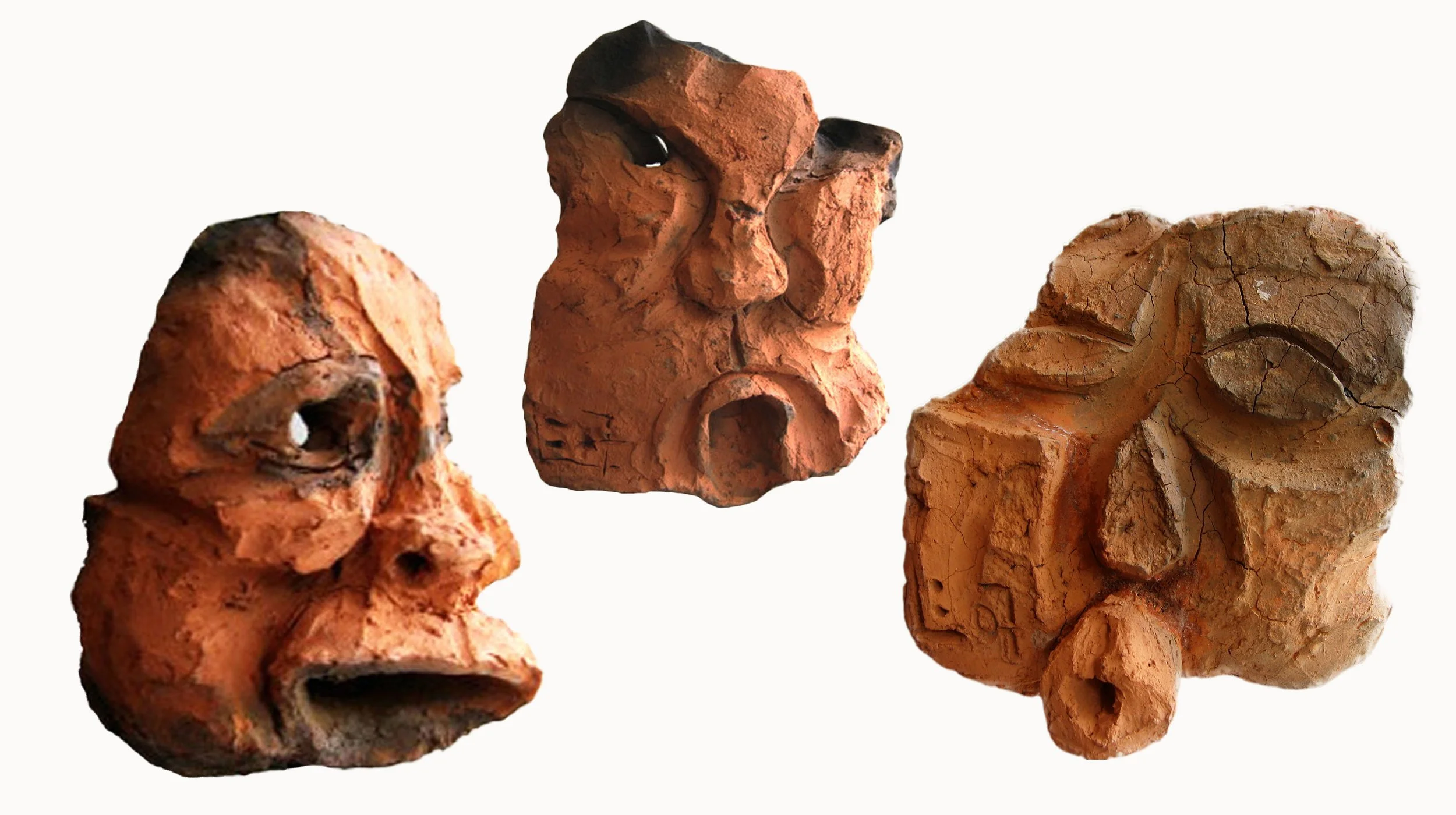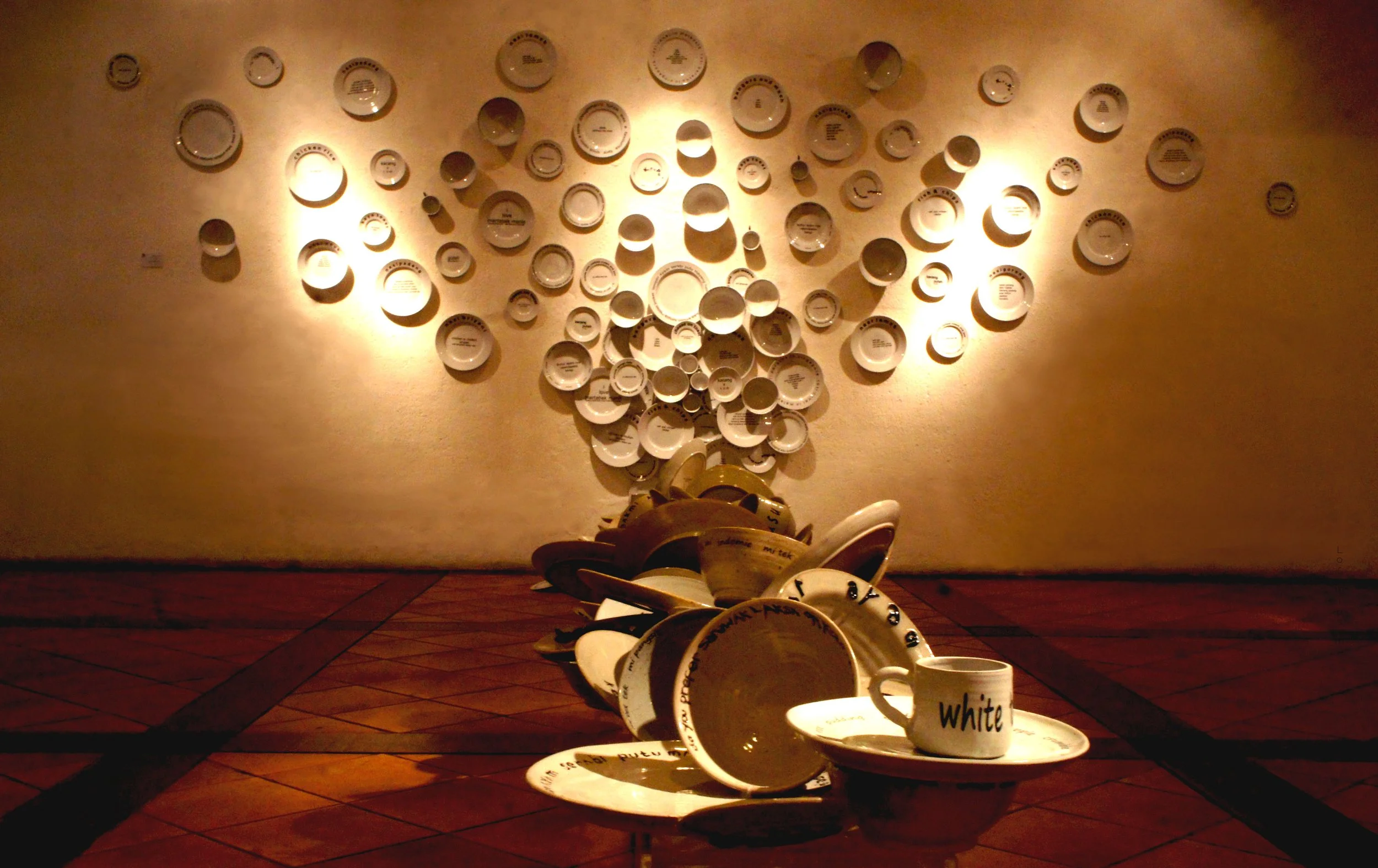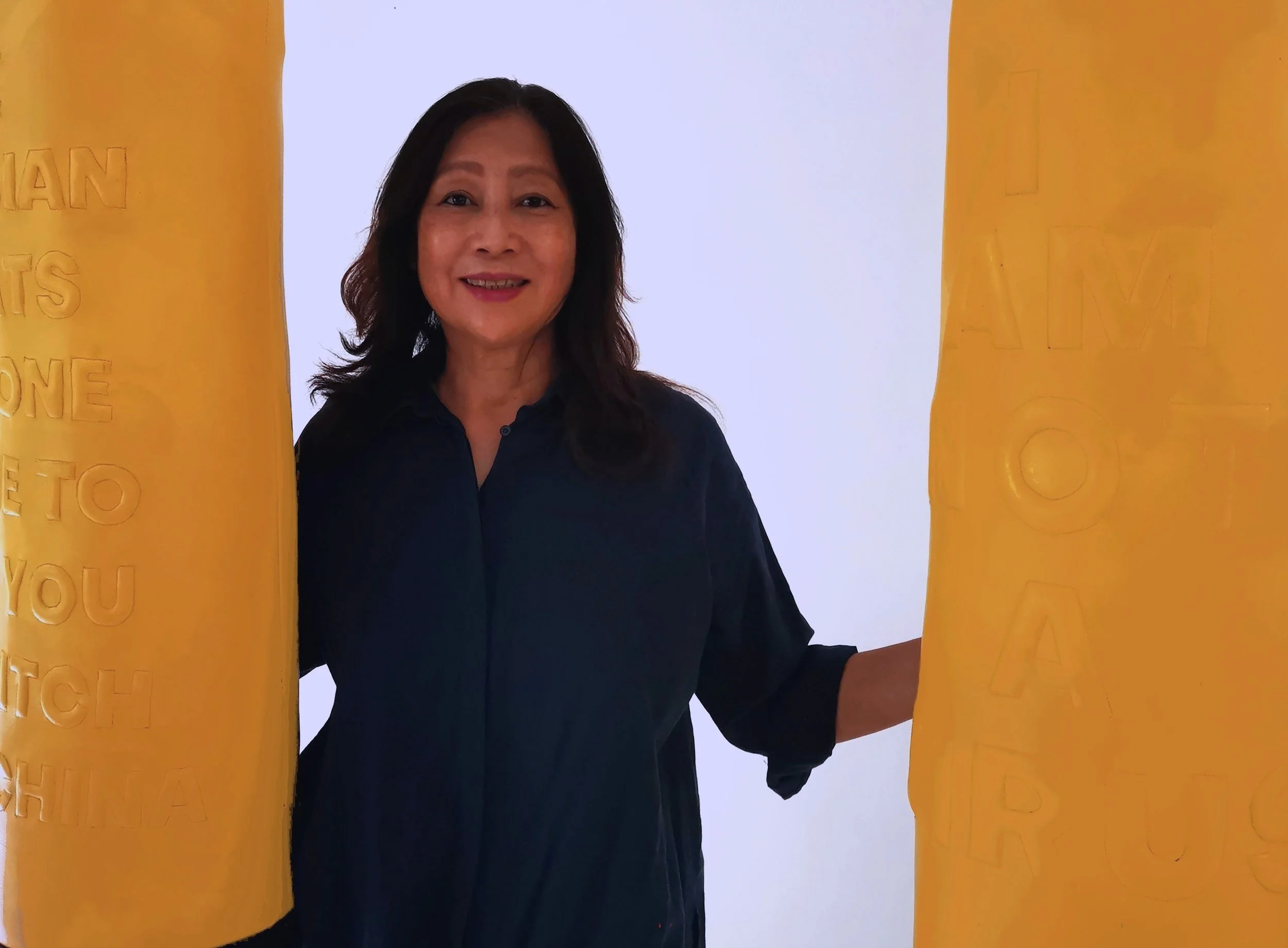
Bibiana Lee
The Human Race - Bibiana Lee
From top to bottom
"A Nation Divided" - print in aluminium, 6 x 60 cm, (2022)
Pieces of May is the digital print of the actual porcelain from the I AM CHINA series exhibited at the id: Sengkarut Identitas exhibition at Galeri Nasional Indonesia in 2019.
The atrocities against the Indonesian Chinese in May 1998 is narrated in the text that beguilingly look like beautiful motifs that can be found on Peranakan Porcelains."The Human Race" - (installation), variable dimension, metal box, LED Lights, (2022)
Human Race puts forward hypothetical questions to increase awareness on the issue of racism vs humanity. The red LED lights have been chosen as a reminder that
underneath the various colours of the human skin, all human bleed the same colour. Racism tend to be latent and takes little to surface as seen historically and in recent times.“I AM NOT A VIRUS” - (installation), variable dimensions, metal chain, synthetic leather, rubber shavings, (2021)
I AM NOT A VIRUS is an installation consisting of 4 punchbags that are used as metaphor for Asians, especially of Chinese descent, who are usually passive in nature,
who have been abused (physically and verbally) like the passive punchbags during the pandemic. Xenophobia reared its ugly head all over the world, speared byignorance and hoaxes about the corona virus and rhetoric by irresponsible people of power.
“I AM NOT A VIRUS” - (installation), variable dimensions, metal chain, synthetic leather, rubber shavings, (2021)
“I AM NOT A VIRUS” - (installation), variable dimensions, metal chain, synthetic leather, rubber shavings, (2021)
“A Nation Divided” Digital print on aluminium, 60 x 60 cm, (2022)
A Nation divided is the digital print of the actual porcelain from the I AM CHINA series exhibited at the id: Sengkarut Identitas exhibition at Galeri Nasional Indonesia in 2019.
Upon closer inspection, the narration of how Indonesia, as a country was divided into 2 opposing sides that support opposing political candidates during the Jakarta Gubernatorial Election.
The text also narrates how social media was used to spread truths and hoaxes during the political campaigns.“ScreamS 5,8,11 “- variable dimensions, terracotta, (2007)
“Some of my Favourite Things” (installation), variable dimensions, plates, bowls, and porcelain cups, (2015)
The photo shows Some of my Favourite Things installation of ready-made crockeries as on which are written the names of Bibiana’s favourite dishes/food,
which turn out to be quite ‘international’ . This artist’s personal food palate is one that has been influenced by the many places she has stayed before.
This art work talks about the influence of globalization by using food as metaphor.“The Professionals II” - : painting in mix media, 150 x 100 cm, (2009)
The Professionals II painting received the Honorable Mention Award during the 2009 Art and Photography Exhibition by the Indonesian Heritage Society.
This painting is in mix media and recognizes one of the essential services provided by the profession depicted on the painting.
Bibiana Lee (b.1956)
BIBIANA LEE tries to incite a more critical consciousness of what is happening around her through her art works. Most of her works are based on research of real - life events. Discrimination against minorities, injustice, repression, identity (politics), gender, as well as socio-economic, globalization and environmental issues are expressed through her 2 as well as 3-dimensional, interactive and video works often incorporating text or words over an array of media. Her works which often give voice to the voiceless, can be seen via her website: www.bibiana-art.com.
In 2005, she was a finalist in IGDS (Indonesian Good Design Selection) for her M'bok Jamu ceramics/dinnerware design. In 2009 she received the Honorable Mention Award of the Art & Photography Exhibition of the Indonesian Heritage Society. The following are some of her selected exhibitions:
Bibiana Lee’s professional career as an artist has followed a meandering path through life with art, which began in the early 2000s. It is a path that shows continuous endeavors, experimenting with a plethora of materials and techniques (drawing, painting, collage, digital printing, sculptures in terra-cotta and bronze, video and photography as well as 3-dimensional installations with ready-mades such as ceramic porcelain, glass, and written texts or words incorporated within her works).
Identity and the lot of the less fortunate or the downtrodden and the human condition are themes that run as a red thread through her oeuvre which particularly found its culmination in her preeminent solo show in 2019 (I Am China), as part of the id:Sengkarut Identitas show. The project was born out of a grave concern with the human condition, particularly that of the ethnic Chinese. It was a time when identity politics was a hot topic socially and politically.
Being a Chinese Indonesian and a woman at that, she had faced stereotyping and forms of discrimination towards Indonesians of Chinese descent throughout her life. But it was when the popular Christian Chinese Jakarta Governor Basuki Tjahaja Purnama or Ahok faced rampant racial campaigning and ultimately lost his bid to be re-elected that led to her major show of ceramic porcelain chronicling the entire history of discrimination against ethnic Chinese in Indonesia.
The situation inspired her ‘master project’ I Am China (2019), using fine fragile porcelain (for which the English word is china), an analogy for the fragile position of the Chinese Indonesian in society. Infused with symbolic tokens and symbolic meaning of colors and with writings on the rim of the ceramic plates as well as the pictorial seeming peranakan designs, this extensive, thematically arranged work documents in a series of four, the events Since1740 up to the New Order 1998 tragedy, followed by Reformasi and the 2017 Jakarta gubernatorial election. Revealing the entire history of the Chinese Indonesians to date, it is a first time comprehensive chronicle on porcelain.
The four series were developed into the following sub-themes:
(i) HISTORICAL series, initially appearing as pictorial utensils denoting birds like the phoenix, but a closer look reveals narratives with titles like: a) Indonesian Chinese (telling the history of the early Chinese immigrants in Indonesia); b) Since 1740 (documenting the years of terror targeting the Chinese); c) May 1998 (the ultimate violence against Chinese Indonesians); and d) Orde Baru or The New Order (the era of repression against the Chinese).
(ii) PEACEFUL TIMES series imaged on three plates dominated by pink peony flowers and titled: a) Festivals (Chinese cultural events allowed to be publicly celebrated); b) Pesta Demokrasi/ Democratic Freedom (the Ethnic Chinese are allowed to engage in politics); c) Post 1998 (stories in the era of Gus Dur when ethnic Chinese were freed from the repressive rules of the New Order).
(iii) IDENTITY POLITICS series consisting of one plate and three bowls that are dominated by images of dragons and the green color, and titled: a) Pilgub DKI 2017 (power struggle between a Muslim indigenous Indonesian and a Christian ethnic Chinese Indonesian); b) Walisongo (ironically those who brought Islam to Indonesia were Chinese under the flag of General Cheng Ho from China); c. A Nation Divided (social tensions were exacerbated with issues of SARA); Bhinneka Tunggal Ika (denoting that ethnic Chinese played a part in the freedom struggle and the establishment of the Indonesian Republic marked by diversity).
(iv) WNI KETURUNAN (Chinese Indonesians) series, consisting of a cup and saucer and a small plate with feminine features. But under the seemingly beautiful decorative images lie semi-hidden bad, derogatory words such as babi (pig), kafir (infidel), cina.
As the Covid19 Pandemic spread over the world, it brought back the identity issue on such a level that Asians including Chinese or those of Chinese descent had to feel the brunt, being accused and attacked as those who brought the virus.
This led Bibiana to file a strong protest in the form of an interactive art installation titled I AM NOT A VIRUS which will see the light at the exhibition opening of Indonesian Women Artists: Infusions into Contemporary Art (2020-2022). Featuring four yellow punching bags, with quilted text of rhetoric and abusive words used as metaphors to represent Asians, especially those of Chinese descent who have been easy targets due to their passive nature. Why 4 pieces? The number 4 is deemed ‘unlucky’ by most Chinese/Asians, she says.
Another related new work The Human Race is an installation of running text in red color, mimicking the color of blood, which underlines that all human blood has the same color no matter what color the outer skin may be. Bibiana’s concern with identity can be traced to the early 2000s when she designed a series of porcelain tableware with images of ‘M’bok Jamu’ the female street vendors selling herbal drinks. Unbeknownst to her, a friend, representing a producer of fine tableware, submitted the porcelain set for the Indonesian Good Design Selection award of the National Center of Design, and that is how she became, unwittingly, shortlisted for its 2005 Award.
Proficient in various mediums, Bibiana created The Professionals II in mixed media and digital print for which she was awarded an Honorable Mention by the Heritage Society in Jakarta as she portrayed one of the essential services of sewage suction in the Metropolitan city of Jakarta. Always wishing to give a voice to the voiceless, she participated in exhibitions on Jugun Ianfu, the young women who were abducted from their homes in countries under the occupation of the Imperial Japanese Army and forced to become "comfort women."
These comfort women remained in her thoughts and in 2016 she participated again in an exhibition regarding the comfort women. For the exhibition Kitab Visual Ianfu, she created IANJO, an installation consisting of 2 small booths with transparent curtains on which names of the victims had been written and eerily appeared like ghostly and voiceless witnesses of a horrible past. Other works related to the issue included the videos Bukan Kemauan Saya (Not My Desire) and the mixed media painting The Story 1, 2, 3, all related to the exhibition Regarding War in 2009. To evoke awareness for hidden victims, she also created an interactive video work Asshole and interactive installation Shit for the EMPU exhibition at Bentara Budaya Yogyakarta (2015). To visualize the cultural impact of identity in a personal or global perspective, in her work Some of my favorite things for the Percept-See exhibition, Bibiana used food, placed on ready-made porcelain ware, adding written text. (Percept-see exhibition 2015).
On an anecdotal note, as Bibiana was doing research for her exhibition on the comfort women, she became inspired to use more technical mediums like video, digital prints, and mixed media works at a time when paintings and sculptures were the favored art mediums. Earlier she had already explored other mediums and even had a solo exhibition in 2007 (Screams) for which she combined painting with terracotta sculptures.



